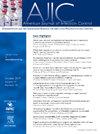医院中与医疗保健相关的艰难梭菌感染或耐甲氧西林金黄色葡萄球菌的组织和基础设施风险因素。
IF 3.8
3区 医学
Q2 INFECTIOUS DISEASES
引用次数: 0
摘要
研究目的本研究探讨了医院中与医疗保健相关的艰难梭菌感染(CDI)和耐甲氧西林金黄色葡萄球菌(MRSA)的基础设施和组织风险因素:这是一项回顾性观察研究,涉及加拿大不列颠哥伦比亚省 12 家医院所有符合条件的住院部,研究时间为 2020 年 4 月 1 日至 2021 年 9 月 16 日。研究结果为 HCA CDI 或 MRSA 的平均感染率。协变量包括但不限于感染控制因素(如手部卫生率)、基础设施因素(如病房年龄)和组织因素(如走廊床位利用率)。进行多变量回归以确定具有统计学意义的风险因素:结果:较老的病房与较高的 HCA CDI 感染率相关(调整后相对风险 (aRR) 为 0.012; 95%ci) :0.012;95%CI [0.004,0.020])。较高的 HCA MRSA 感染率与手部卫生率下降(aRR:-0.035;95%CI [-0.063,-0.008])、较高的 MRSA 生物负荷(aRR:9.008;95%CI [5.586,12.429])、走廊病床使用率增加(aRR:0.680;95%CI [0.094,1.267])、护理加班率增加(aRR:5.018;95%CI [1.210,8.826])以及清洁供应室门未保持关闭(aRR:-0.283;95%CI [-0.536,-0.03]):该研究证实了预防感染的多面性,并强调了跨部门合作对改善患者安全的重要性。本文章由计算机程序翻译,如有差异,请以英文原文为准。
Organizational and infrastructural risk factors for health care–associated Clostridioides difficile infections or methicillin-resistant Staphylococcus aureus in hospitals
Background
This study explores the infrastructural and organizational risk factors for health care–associated (HCA) Clostridioides difficile infections (CDIs) and methicillin-resistant Staphylococcus aureus (MRSA) in hospitals.
Methods
This is a retrospective observational study involving all eligible inpatient units from 12 hospitals in British Columbia, Canada, from April 1, 2020 to September 16, 2021. The outcomes were the average HCA CDI or MRSA rates. Covariates included, but were not limited to, infection control factors (eg, hand hygiene rate), infrastructural factors (eg, unit age), and organizational factors (eg, hallway bed utilization). Multivariable regression was performed to identify statistically significant risk factors.
Results
Older units were associated with higher HCA CDI rates (adjusted relative risk [aRR]: 0.012; 95% confidence interval (CI) [0.004, 0.020]). Higher HCA MRSA rates were associated with decreased hand hygiene rate (aRR: −0.035; 95% CI [−0.063, −0.008]), higher MRSA bioburden (aRR: 9.008; 95% CI [5.586, 12.429]), increased utilization of hallway beds (aRR: 0.680; 95% CI [0.094, 1.267]), increased nursing overtime rate (aRR: 5.018; 95% CI [1.210, 8.826]), and not keeping the clean supply room door closed (aRR: −0.283; 95% CI [−0.536, −0.03]).
Conclusions
The study confirmed the multifaceted nature of infection prevention and emphasized the importance of interdepartmental collaboration to improve patient safety.
求助全文
通过发布文献求助,成功后即可免费获取论文全文。
去求助
来源期刊
CiteScore
7.40
自引率
4.10%
发文量
479
审稿时长
24 days
期刊介绍:
AJIC covers key topics and issues in infection control and epidemiology. Infection control professionals, including physicians, nurses, and epidemiologists, rely on AJIC for peer-reviewed articles covering clinical topics as well as original research. As the official publication of the Association for Professionals in Infection Control and Epidemiology (APIC)

 求助内容:
求助内容: 应助结果提醒方式:
应助结果提醒方式:


